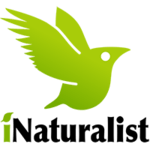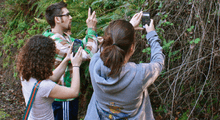iNaturalist
 | |
Type of site | Citizen science |
|---|---|
| Available in | English, Spanish, Galician, Catalan, and Basque |
| Owner | California Academy of Sciences [1] |
| Website |
inaturalist |
| Commercial | No |
| Registration | required |
| Launched | 2008[1] |
| Current status | Online |
iNaturalist is a citizen science project and online social network of naturalists, citizen scientists, and biologists built on the concept of mapping and sharing observations of biodiversity across the globe.[2] Observations may be added via the website or from a mobile application.[3][4] The observations provide valuable open data to a variety of scientific research projects, museums, botanic gardens, parks, and other organizations.[5][6][7] Users of iNaturalist have contributed over two million observations since its founding in 2008,[8] and the project has been called "a standard-bearer for natural history mobile applications."[9]
History
iNaturalist.org began in 2008 as a UC Berkeley School of Information Master's final project of Nate Agrin, Jessica Kline, and Ken-ichi Ueda.[1] Nate Agrin and Ken-ichi Ueda continued work on the site with Sean McGregor, a web developer. In 2011, Ueda began collaboration with Scott Loarie, a research fellow at Stanford University and lecturer at UC Berkeley. Ueda and Loarie are the current co-directors of iNaturalist.org. On April 24, 2014 iNaturalist.org merged with the California Academy of Sciences [10] In 2014, iNaturalist celebrated its one millionth observation.[11]
Participation
The iNaturalist platform is based on crowdsourcing of data. Users of iNaturalist can submit observations of organisms in the form of photographs, sound recordings, or visual sightings. Observations are either "casual" or "research" grade, and research grade observations are incorporated into online databases to be utilizable for scientists.[6] iNaturalist is the preferred application for crowd-sourced biodiversity data in Mexico.[12]

As of 1 May 2016, the iNaturalist community consisted of more than 200,000 users contributing over 2,500,000 observations[13] of plants, animals, and other organisms worldwide. Users have created and contributed to over 2000 different projects,[14] spanning hundreds of themes.
A few project examples include taxa- and location-specific bioblitzes, roadkill observations, animal tracks, and documenting the spread of invasive species. The US National Park Service partnered with iNaturalist to record observations from the 2016 National Parks BioBlitz. That project exceeded 100,000 observations in August 2106.[15] In 2011 iNaturalist was used as a platform to power concurrent Global Amphibian and Global Reptile BioBlitzes, in which observations were used to help monitor the occurrence and distribution of the world's reptiles and amphibian species.[16]
See also
References
- 1 2 3 "About". 5 August 2013. Retrieved 7 August 2013.
- ↑ "San Francisco's Parks Scoured in Wildlife Inventory". 7 May 2014. Retrieved 31 January 2015.
- ↑ "iNaturalist application (iTunes Store)". 25 June 2013. Retrieved 7 August 2013.
- ↑ "iNaturalist application (Google Play)". 4 June 2013. Retrieved 7 August 2013.
- ↑ "Encyclopedia of Life and iNaturalist work together to support citizen science". 18 June 2012. Retrieved 7 August 2013.
- 1 2 Bowser, A., Wiggins, A., Shanley, L., Preece, J., & Henderson, S. (2014). "Sharing data while protecting privacy in citizen science" (PDF). Interactions. 21 (1): 70–73.
- ↑ Pimm, S.; et al. (30 May 2014). "The biodiversity of species and their rates of extinction, distribution, and protection". Retrieved 31 January 2015.
- ↑ "Citizen Science Network iNaturalist Celebrates Millionth Nature Observation as it Launches New Visual Maps". 14 Nov 2014. Retrieved 31 January 2015.
- ↑ Goldsmith, G. R. (6 August 2015). "The field guide, rebooted". Science. 349 (6248): 594–594. doi:10.1126/science.aac7810.
- ↑ "California Academy of Sciences Acquires iNaturalist". 14 May 2014. Retrieved 14 May 2014.
- ↑ Hance, Jeremy (November 10, 2014). "Citizen scientist site hits one million observations of life on Earth". Mongabay.
- ↑ Pimm, S. L.; Jenkins, C. N.; Abell, R.; Brooks, T. M.; Gittleman, J. L.; Joppa, L. N.; Raven, P. H.; Roberts, C. M.; Sexton, J. O. (2014). "The biodiversity of species and their rates of extinction, distribution, and protection" (PDF). Science. 344 (6187): 1246752–1246752. doi:10.1126/science.1246752.
- ↑ "Observations". 7 November 2014. Retrieved 7 November 2014.
- ↑ "Projects". 7 August 2013. Retrieved 7 August 2013.
- ↑ Seltzer, Carrie (2016-08-25). "Citizen scientists give NPS 100,000+ biodiversity records for 100th birthday". National Geographic Society (blogs). Retrieved 2016-09-17.
- ↑ Holtz, Debra Levi (October 10, 2011). "Reptile, amphibian BioBlitzes tap social media". San Francisco Chronicle.
External links
- Official website
- iNaturalist on Vimeo
- Introducing iNaturalist by Suzanne Cadwell